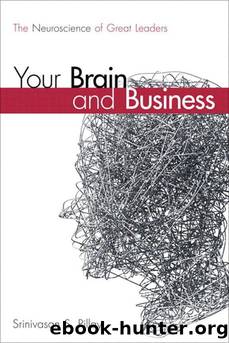Your Brain and Business: The Neuroscience of Great Leaders by Srinivasan S. Pillay

Author:Srinivasan S. Pillay [Pillay, Srinivasan S.]
Language: eng
Format: epub
ISBN: 9780137064441
Amazon: 0137064446
Publisher: FT Press
Published: 2011-03-02T16:00:00+00:00
The Entrapment of Context
The concept: One of the major challenges to new learning is âcontext.â Experiments have shown that context is a major determinant of conditioning.6â8 Here are some examples of how context influences our decisions:
⢠âThat skirt is too sexy for work.â
⢠âI have to show my serious side at work.â
⢠âJust walking in the front door makes me nauseous.â
⢠âJust seeing my boss makes me nervous.â
⢠âFemale bosses are always so touchy-feely.â
Context can involve a place, person, or role that has become defined and influential within oneâs belief set. However, regardless of this external context, context is seen and defined by our brains.
A large number of brain structures are implicated in contextual conditioning in humans.8 Of these, the amygdala and hippocampus stand out.7 The automatic emotional reactions of the amygdala to context and the shaping influences of long-term memories of the hippocampus form the canvas upon which all thoughts are experienced. Thus, they form automatic and relatively fixed reactions to events in the environment. Sometimes, these effects are so strong that we have to choose another canvas upon which to view our thoughts. This is the role of the manager or coach. A coachâs job in contextual conditioning is to assist the client in redefining the context so that new behaviors can emerge. In effect, it is to change amygdala activation.9 Again, remember that internal context (the brain) is what defines how external context is experienced.
For contextual conditioning to be reversed, the brainâs accountant (the vmPFC) has to inhibit amygdala activation.10 (Note that the amygdala has multiple nuclei that have different functions here; these details are less applicable at the current time.)11 Also, the conflict and attention center (the ACC) is activated during extinction of the automatic response. That is, when you try to reverse a habit, the brain goes into a state of conflict and tries to hold onto the habit, using emotional distress (amygdala activation) as the threat if you change.
The application: It is important be attentive to the influences of conscious and unconscious fear on behavior. When the amygdala is overstimulated over a period of time, it continues to send messages to the hippocampus, especially during contextual fear conditioning, and vice versa. In other words, long-term memories shape the meaning of current fears and may distort them or add to them. This is the reason for bringing the attention to the momentâthe past is too distracting. We have to remember that memories are not just cognitions and not just thinking. They are emotions as well. In fact, emotional memories are some of our strongest memories. And sometimes, they are intangible and unrecognizable but very impactful indeed. Thus, when youâre trying to change, it is important to ask, âWhat is the context of this need to change?â For example, does it have to do with general life boredom? Does it have to do with pain? Does it have to do with power? One can benefit from understanding the details of these hippocampal memories in order to stand a better chance of progress.
Download
This site does not store any files on its server. We only index and link to content provided by other sites. Please contact the content providers to delete copyright contents if any and email us, we'll remove relevant links or contents immediately.
Storytelling for dummies by Andrea Fontana(1485)
Effortless by Greg McKeown(1422)
The Practice by Seth Godin(1394)
Mastering Blockchain by Lorne Lantz(1387)
Blockchain Quick Reference by Paul Valencourt & Samanyu Chopra & Brenn Hill(1144)
Mastering Blockchain by Lorne Lantz & Daniel Cawrey(904)
The wind in the willows by Kenneth Grahame(837)
How to Lead by David M. Rubenstein(814)
The Ape in the Corner Office by Richard Conniff(783)
Handbook of Big Data Analytics by Unknown(705)
Social Media Engagement For Dummies by Aliza Sherman(703)
Taking Care of Yourself (HBR Working Parents Series) by Harvard Business Review(688)
Getting Started with Data: The first book you should read to successfully get along with data. by Menegatti Gabriel & Team Simbiose Ventures(687)
FunRetrospectives: activities and ideas for making agile retrospectives more engaging by Paulo Caroli & Tainã Caetano Coimbra(685)
Business Storytelling For Dummies by Unknown(663)
Evernote for Self Publishing: How to Write Your Book in Evernote from Start to Finish by Jose John(660)
Help! My Facebook Ads Suck-- by M. D. Cooper & Jill Cooper(646)
A Leader Listens by Ajay Banga(634)
Genius by Choice: Your unconventional A–Z handbook to enhance your learning process by Remondino Giulia S(630)
